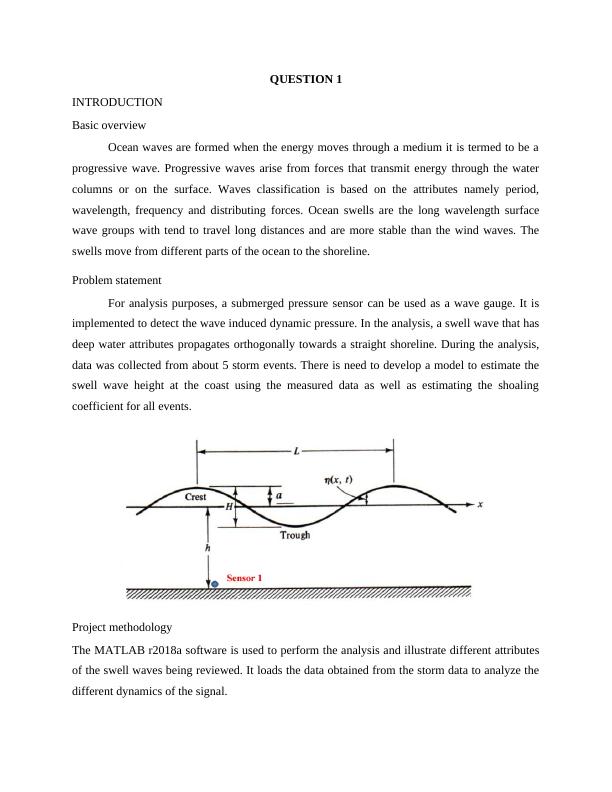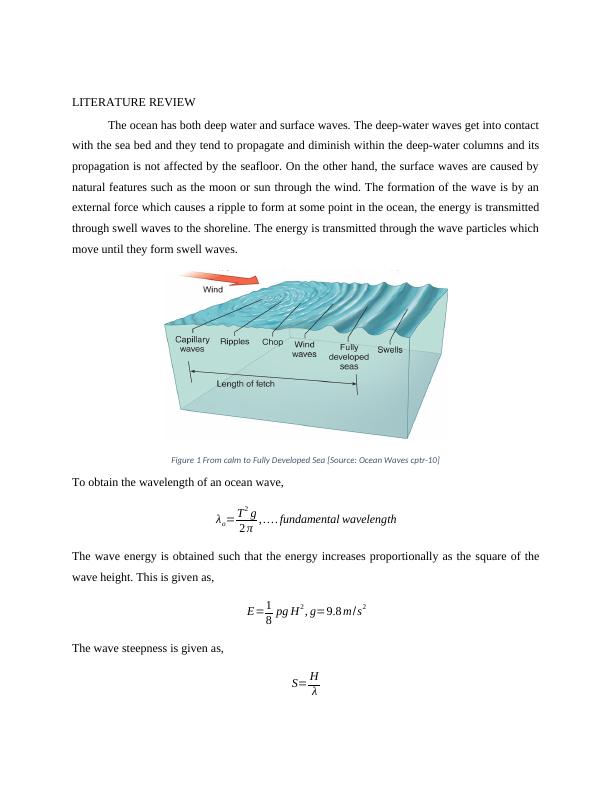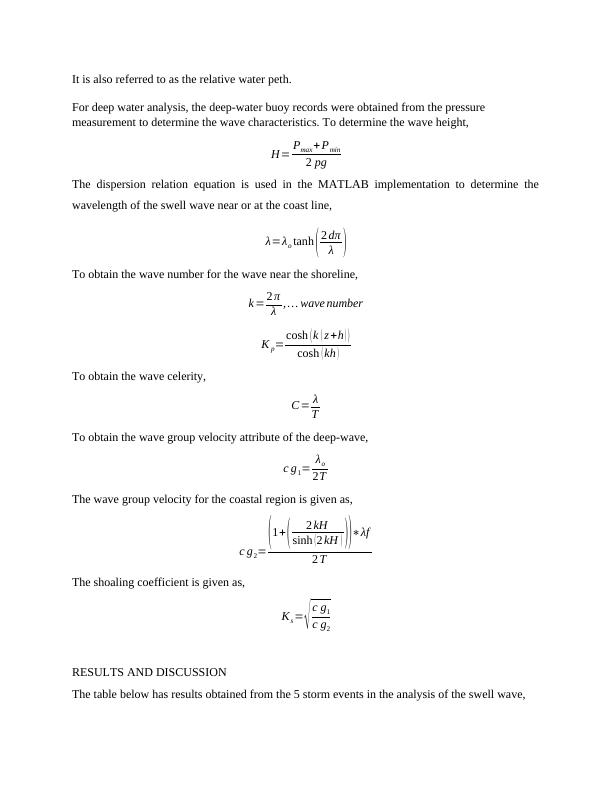Simple Coastal Models - Assignment 1
Added on 2023-06-10
13 Pages2158 Words360 Views
2018
GRIFFITH UNIVERSITY
COASTAL ENGINEERING AND MODELLING-6110 ENG
TRIMESTER 1, 2018
TITLE: SIMPLE COASTAL MODELS
ASSIGNMENT 1
STUDENT NAME
STUDENT ID NUMBER
PROFESSOR (TUTOR)
DATE OF SUBMISSION
GRIFFITH UNIVERSITY
COASTAL ENGINEERING AND MODELLING-6110 ENG
TRIMESTER 1, 2018
TITLE: SIMPLE COASTAL MODELS
ASSIGNMENT 1
STUDENT NAME
STUDENT ID NUMBER
PROFESSOR (TUTOR)
DATE OF SUBMISSION

QUESTION 1
INTRODUCTION
Basic overview
Ocean waves are formed when the energy moves through a medium it is termed to be a
progressive wave. Progressive waves arise from forces that transmit energy through the water
columns or on the surface. Waves classification is based on the attributes namely period,
wavelength, frequency and distributing forces. Ocean swells are the long wavelength surface
wave groups with tend to travel long distances and are more stable than the wind waves. The
swells move from different parts of the ocean to the shoreline.
Problem statement
For analysis purposes, a submerged pressure sensor can be used as a wave gauge. It is
implemented to detect the wave induced dynamic pressure. In the analysis, a swell wave that has
deep water attributes propagates orthogonally towards a straight shoreline. During the analysis,
data was collected from about 5 storm events. There is need to develop a model to estimate the
swell wave height at the coast using the measured data as well as estimating the shoaling
coefficient for all events.
Project methodology
The MATLAB r2018a software is used to perform the analysis and illustrate different attributes
of the swell waves being reviewed. It loads the data obtained from the storm data to analyze the
different dynamics of the signal.
INTRODUCTION
Basic overview
Ocean waves are formed when the energy moves through a medium it is termed to be a
progressive wave. Progressive waves arise from forces that transmit energy through the water
columns or on the surface. Waves classification is based on the attributes namely period,
wavelength, frequency and distributing forces. Ocean swells are the long wavelength surface
wave groups with tend to travel long distances and are more stable than the wind waves. The
swells move from different parts of the ocean to the shoreline.
Problem statement
For analysis purposes, a submerged pressure sensor can be used as a wave gauge. It is
implemented to detect the wave induced dynamic pressure. In the analysis, a swell wave that has
deep water attributes propagates orthogonally towards a straight shoreline. During the analysis,
data was collected from about 5 storm events. There is need to develop a model to estimate the
swell wave height at the coast using the measured data as well as estimating the shoaling
coefficient for all events.
Project methodology
The MATLAB r2018a software is used to perform the analysis and illustrate different attributes
of the swell waves being reviewed. It loads the data obtained from the storm data to analyze the
different dynamics of the signal.

LITERATURE REVIEW
The ocean has both deep water and surface waves. The deep-water waves get into contact
with the sea bed and they tend to propagate and diminish within the deep-water columns and its
propagation is not affected by the seafloor. On the other hand, the surface waves are caused by
natural features such as the moon or sun through the wind. The formation of the wave is by an
external force which causes a ripple to form at some point in the ocean, the energy is transmitted
through swell waves to the shoreline. The energy is transmitted through the wave particles which
move until they form swell waves.
Figure 1 From calm to Fully Developed Sea [Source: Ocean Waves cptr-10]
To obtain the wavelength of an ocean wave,
λo= T2 g
2 π , ... . fundamental wavelength
The wave energy is obtained such that the energy increases proportionally as the square of the
wave height. This is given as,
E=1
8 pg H2 , g=9.8 m/s2
The wave steepness is given as,
S= H
λ
The ocean has both deep water and surface waves. The deep-water waves get into contact
with the sea bed and they tend to propagate and diminish within the deep-water columns and its
propagation is not affected by the seafloor. On the other hand, the surface waves are caused by
natural features such as the moon or sun through the wind. The formation of the wave is by an
external force which causes a ripple to form at some point in the ocean, the energy is transmitted
through swell waves to the shoreline. The energy is transmitted through the wave particles which
move until they form swell waves.
Figure 1 From calm to Fully Developed Sea [Source: Ocean Waves cptr-10]
To obtain the wavelength of an ocean wave,
λo= T2 g
2 π , ... . fundamental wavelength
The wave energy is obtained such that the energy increases proportionally as the square of the
wave height. This is given as,
E=1
8 pg H2 , g=9.8 m/s2
The wave steepness is given as,
S= H
λ

It is also referred to as the relative water peth.
For deep water analysis, the deep-water buoy records were obtained from the pressure
measurement to determine the wave characteristics. To determine the wave height,
H= Pmax + Pmin
2 pg
The dispersion relation equation is used in the MATLAB implementation to determine the
wavelength of the swell wave near or at the coast line,
λ=λo tanh ( 2 dπ
λ )
To obtain the wave number for the wave near the shoreline,
k = 2 π
λ , ... wave number
K p= cosh ( k ( z +h ) )
cosh ( kh )
To obtain the wave celerity,
C= λ
T
To obtain the wave group velocity attribute of the deep-wave,
c g1= λo
2T
The wave group velocity for the coastal region is given as,
c g2=
(1+ ( 2 kH
sinh (2 kH ) ))∗λf
2 T
The shoaling coefficient is given as,
Ks = √ c g1
c g2
RESULTS AND DISCUSSION
The table below has results obtained from the 5 storm events in the analysis of the swell wave,
For deep water analysis, the deep-water buoy records were obtained from the pressure
measurement to determine the wave characteristics. To determine the wave height,
H= Pmax + Pmin
2 pg
The dispersion relation equation is used in the MATLAB implementation to determine the
wavelength of the swell wave near or at the coast line,
λ=λo tanh ( 2 dπ
λ )
To obtain the wave number for the wave near the shoreline,
k = 2 π
λ , ... wave number
K p= cosh ( k ( z +h ) )
cosh ( kh )
To obtain the wave celerity,
C= λ
T
To obtain the wave group velocity attribute of the deep-wave,
c g1= λo
2T
The wave group velocity for the coastal region is given as,
c g2=
(1+ ( 2 kH
sinh (2 kH ) ))∗λf
2 T
The shoaling coefficient is given as,
Ks = √ c g1
c g2
RESULTS AND DISCUSSION
The table below has results obtained from the 5 storm events in the analysis of the swell wave,

End of preview
Want to access all the pages? Upload your documents or become a member.
Related Documents
Simple Coastal Modelslg...
|12
|1430
|205
Erosion and Deposition Assignmentlg...
|5
|1113
|74
